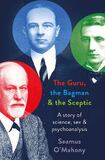
The author of this book, a medical doctor and award-winning writer from Cork who has worked in Ireland and Britain, says that he wrote it partly to explore why he has always been “bothered” by psychoanalysis, the practice created and popularised by Sigmund Freud early in the last century.
Freud (1891-1939) is the guru in the title. The bagman and the sceptic are, respectively, a Welsh doctor who became an ardent admirer, promoter and biographer of Freud; and an English surgeon who remained unconvinced about the merits and methods of Freud’s new doctrine.
The Welshman, Ernest Jones, and the Englishman, Wilfred Trotter, were colleagues at University College Hospital, London, sharing a house and consultancy rooms in Harley Street, when they both became sufficiently interested in Freud’s work to learn German to study his writings. Jones became an unwavering disciple, while Trotter remained a lifelong sceptic even as the pair remained friends and became brothers-in-law when Trotter married Jones’s sister.
Disregarding Freud’s pronouncement that “biographical truth is not to be had”, O’Mahony has constructed compelling, comprehensive and overlapping portraits of the three men, interwoven with succinct overviews of medical practice in England in the first half of the last century, and of the growth of psychoanalysis in inter-war Vienna and in post-second World War North America, where New York City alone had four-times as many analysts as all of Britain. A Venn diagram featuring the three protagonists would show large overlaps between Freud and Jones and between Jones and Trotter, but almost no intersection between Trotter and Freud.
Excuse My French restaurant review: An experience simply unlike anything else in Dublin
Ireland’s remote islands: Only 29 apply for €84,000 grant aimed at attracting residents
10 of the best new shows to watch in April: including Netflix medical drama and two AppleTV+ releases
MobLand review: Pierce Brosnan’s Irish accent is a horror for the ages. Forget licence to kill, this is more Darby O’Gill
Jones (1879-1958) meets many of the dictionary definitions of the soubriquet “bagman”. He procured most of Freud’s English clients, helped Freud and his entourage to escape post-Anchluss Austria and wrote the best-known Freud biography. In his 20s, he was acquitted by a London court of indecently assaulting three intellectually disabled schoolgirls, but he was later forced to resign from a London West End hospital following similar but unrelated complaints.
After visiting Freud in Salzburg, Jones made study visits to various European cities and spent some years in Canada, where he saw off more complaints about his professional and personal behaviour. Returning to London, he founded the British Psychoanalytical Society and established a private practice that enabled him in little more a decade to acquire a home near Regent’s Park, a country house, a cottage in Wales and a summer house on the French Riviera.
Wealthy mistress
When he was no longer sleeping with his long-term wealthy mistress, Loe Kann, he told Freud that he gave in to temptation to find comfort in the arms and bed of their housemaid. When Freud’s daughter, Anna, moved to London after finishing school, Freud warned Jones not to try to seduce her. Jones wrote books on figure skating and on Shakespeare’s Hamlet (a major influence on Laurence Olivier and others) before his three-volume Freud biography.
Trotter (1872-1939), although now forgotten even in the hospital where he was once revered, was for many years the most famous surgeon in England. In contrast to Jones and Freud, he had no interest in money or titles. Summoned to Buckingham Palace in 1929 to examine the ailing King George V and told that a car and driver would fetch him, he replied: “No, that won’t be necessary. I can take the No 14 bus.” He is credited with coining the term “herd instinct” (cited by Boris Johnson in his resignation speech) in his 1916 bestseller The Instincts of the Herd in Peace and War. A sceptic and empiricist who even had seven of his own cutaneous nerves severed to disprove a medical journal article, he could never accept Freud’s speculative theories because they were not based on scientific facts.
O’Mahony shares Trotter’s scepticism. Psychoanalysis is no longer fashionable, and is now even somewhat disreputable, he writes. Though Freud started out as a neurologist, he became more a guru than a healer. For all his fame and cultural prominence, he was “indifferent to the outcome of his therapy” and he regarded most people as “rabble”. Most of his early acolytes lacked formal scientific or medical training. His analysands (including, dubiously, his own daughter Anna) quickly became analysts – “couch-jumpers” as O’Mahony delights in dubbing them.
This book will be of particular value to medical practitioners, but it also contains much to inform and entertain a general reader. Its many digressions on, among others, Freud’s relatives, Britain’s current King Charles’s grandmother and Princess Marie Bonaparte are illuminating and sardonic. Samuel Beckett and William Butler Yeats get passing mentions, as does Anna Freud’s holiday home in Baltimore, west Cork.
Freudians, O’Mahony concludes, hate mockery but fear indifference even more. This book might reverse that preference.












